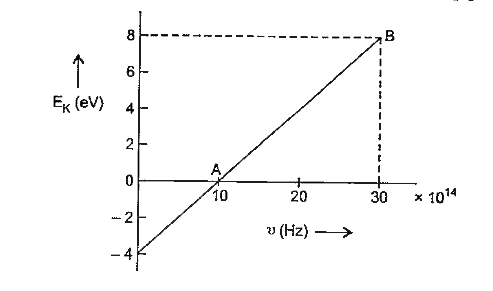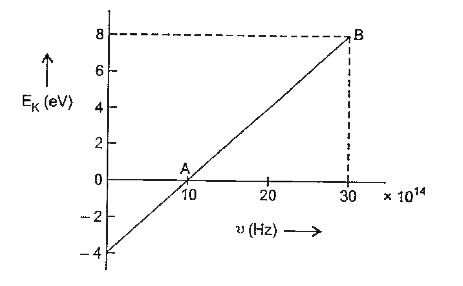What is the effect on the maximum kinetic energy and the numver of photoelectrons when (i) The intensity of incident light decreases. (ii) The emitting surcac is charged. (iii) Wavelength of incident light increase.
The correct Answer is:(i) Number of electrono ejected from the surface will decrease and no effect on kinetic energy of electron.
(ii) No effect on number of electrons but kinetic energy will change.
(iii) Kinetic energy will decrease and no effect on number of photo electrons.
To solve the question regarding the effect on the maximum kinetic energy and the number of photoelectrons under different conditions, we will analyze each case step by step.
1. Understanding Maximum Kinetic Energy (KE_max):
- The maximum kinetic energy of photoelectrons is given by the equation:
KEmax=hν−ϕ
where h is Planck's constant, ν is the frequency of the incident light, and ϕ is the work function of the material.
2. Effect of Intensity on KE_max:
- The intensity of light is related to the number of photons hitting the surface per unit time. However, the maximum kinetic energy depends only on the frequency of the incident light and the work function.
- Therefore, a decrease in intensity does not affect the maximum kinetic energy:
No change in KEmax
3. Effect on Number of Photoelectrons:
- The number of photoelectrons emitted is directly proportional to the intensity of the light. If intensity decreases, the number of photons also decreases, leading to a decrease in the number of emitted photoelectrons:
Number of photoelectrons decreases
Case (ii): The emitting surface is charged.
1. Effect on KE_max:
- Changing the emitting surface affects the work function ϕ. If the work function changes, the maximum kinetic energy will also change according to the equation:
KEmax=hν−ϕ
- Therefore, if the work function increases, KEmax decreases, and vice versa:
KEmax changes
2. Effect on Number of Photoelectrons:
- The number of photoelectrons emitted is independent of the work function. Thus, changing the emitting surface does not affect the number of photoelectrons:
No change in number of photoelectrons
Case (iii): Wavelength of incident light increases.
1. Effect on KE_max:
- The maximum kinetic energy can also be expressed in terms of wavelength:
KEmax=hcλ−ϕ
- If the wavelength λ increases, the term hcλ decreases, leading to a decrease in maximum kinetic energy:
KEmax decreases
2. Effect on Number of Photoelectrons:
- The number of photoelectrons emitted depends on whether the wavelength is below the threshold wavelength λ0. If the wavelength increases beyond the threshold, no photoelectrons are emitted:
If λ>λ0, no photoelectrons emitted
- Therefore, if the wavelength increases and exceeds the threshold, the number of photoelectrons will decrease or become zero.
Summary of Effects:
- Case (i):
- KE_max: No change
- Number of photoelectrons: Decreases
- Case (ii):
- KE_max: Changes (depends on work function)
- Number of photoelectrons: No change
- Case (iii):
- KE_max: Decreases
- Number of photoelectrons: Decreases or becomes zero if wavelength exceeds threshold.
- The maximum kinetic energy of photoelectrons is given by the equation:
KEmax=hν−ϕ
where h is Planck's constant, ν is the frequency of the incident light, and ϕ is the work function of the material.
- The intensity of light is related to the number of photons hitting the surface per unit time. However, the maximum kinetic energy depends only on the frequency of the incident light and the work function.
- Therefore, a decrease in intensity does not affect the maximum kinetic energy:
No change in KEmax
- The number of photoelectrons emitted is directly proportional to the intensity of the light. If intensity decreases, the number of photons also decreases, leading to a decrease in the number of emitted photoelectrons:
Number of photoelectrons decreases
- Changing the emitting surface affects the work function ϕ. If the work function changes, the maximum kinetic energy will also change according to the equation:
KEmax=hν−ϕ
- Therefore, if the work function increases, KEmax decreases, and vice versa:
KEmax changes
- The number of photoelectrons emitted is independent of the work function. Thus, changing the emitting surface does not affect the number of photoelectrons:
No change in number of photoelectrons
- The maximum kinetic energy can also be expressed in terms of wavelength:
KEmax=hcλ−ϕ
- If the wavelength λ increases, the term hcλ decreases, leading to a decrease in maximum kinetic energy:
KEmax decreases
- The number of photoelectrons emitted depends on whether the wavelength is below the threshold wavelength λ0. If the wavelength increases beyond the threshold, no photoelectrons are emitted:
If λ>λ0, no photoelectrons emitted
- Therefore, if the wavelength increases and exceeds the threshold, the number of photoelectrons will decrease or become zero.
- Case (i):
- KE_max: No change
- Number of photoelectrons: Decreases
- Case (ii):
- KE_max: Changes (depends on work function)
- Number of photoelectrons: No change
- Case (iii):
- KE_max: Decreases
- Number of photoelectrons: Decreases or becomes zero if wavelength exceeds threshold.
Topper's Solved these Questions
- BOOK - ALLENCHAPTER - SIMPLE HARMONIC MOTIONEXERCISE - Exercise-05(B)46videos
SIMPLE HARMONIC MOTION
- BOOK - ALLENCHAPTER - SIMPLE HARMONIC MOTIONEXERCISE - MCQ s8videos
SIMPLE HARMONIC MOTION
- BOOK - ALLENCHAPTER - SIMPLE HARMONIC MOTIONEXERCISE - Exercise - 581videos
SIMPLE HARMONIC MOTION
- BOOK - ALLENCHAPTER - RACEEXERCISE - Basic Maths (Wave Motion & Dopplers Effect) (Stationary waves & doppler effect, beats)24videos
RACE
- BOOK - ALLENCHAPTER - TEST PAPEREXERCISE - PHYSICS4videos
TEST PAPER
Similar Questions
As the intensity of incident light increases
View SolutionIn a photoelectric emission process the maximum energy of the photo - electrons increase with increasing intensity of the incident light .
View SolutionMaximum kinetic energy of a photoelectron is E when the wavelength of incident light is λ. If energy becomes four times when wavelength is reduced to one thrid, then work function of the metal is
View SolutionThe kinetic energy of photo electrons depends on
(A) Frequency of incident radiation
(B) Velocity of incident radiation
(C) Intensity of incident radiation
(D) Wavelength of incident radiationView SolutionIn the shown expermiental setup to study photoelectric effect, two conducting electrodes are enclosed in an evacuated glass-tube as shown. A parallel beam of monochromatic light, falls on photosensitive electrodes. The emf of battery shwon is high enough such that all photoelectron ejected from left electrode will reach the right electrode. Under initial conditions photoelectrons are emitted. AS changes are made in each situation of column-I, Match the statements in column-I with results in column-II.
_E01_128_Q01.png)
Column IColumn II(A)If frequency of incident light is increased keeping its intensity constant(p)magnitude of stopping potential(B)If frequency of incident light is increased and its intensity is decreased(q)current through circuit may stop(C)If work function of photo sensitive electrode is increased(r)maximum kinetic energy of ejected photoelectrons will increase(D)If intensity of incident light is increased keeping its frequency constant(s)saturation current will increaseView SolutionFor the photoelectric effect, the maximum kinetic energy Ek of the emitted photoelectrons is plotted against the frequency of the incident photons as shown in the figure. The slope of the curve gives
 View Solution
View SolutionFind the maximum kinetic energy of the photoelectrons ejected when light of wavelength 350nm is incident on a cesium surface. Work function of cesium = 1.9eV.
View SolutionIf intensity of incident light is increased in photo electric effect then which of the following is true ?
View SolutionIn an experiment of photo-electric effect, the graph of maximum kinetic energy Ek of the emitted photoelectrons versus the frequency v of the incident light is a straight line AB as shown in figure below :

Threshold frequency of the metal.View SolutionIn an experiment of photo-electric effect, the graph of maximum kinetic energy Ek of the emitted photoelectrons versus the frequency v of the incident light is a straight line AB as shown in figure below :

Work function of the metal.View Solution

